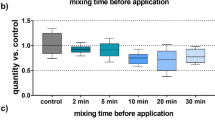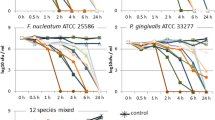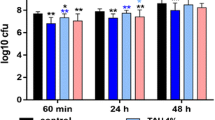Abstract
Objectives
The aim of the present study was to assess the antimicrobial activity of a sodium hypochlorite formulation including its components against bacteria associated with periodontal disease.
Materials and methods
Sodium hypochlorite formulation (NaOCl gel), its components sodium hypochlorite (NaOCl), and the activating vehicle were compared with 0.1 % chlorhexidine digluconate (CHX) solution. The antimicrobial activity was proven by determination of minimal inhibitory concentrations (MIC), minimal bactericidal concentrations, and killing assays. Furthermore, the influence on formation as well as on a 4-day-old 6-species biofilm was tested.
Results
Except for one strain (Parvimonas micra ATCC 33270 in case of NaOCl gel), the MICs both of the CHX solution and NaOCl gel did not exceed 10 % of the formulations’ concentration. In general, MICs of the NaOCl gel were equal as of the CHX solution against Gram-negatives but higher against Gram-positive bacteria. CHX but not NaOCl gel clearly inhibited biofilm formation; however, the activity of NaOCl gel was more remarkable on a 4-day-old biofilm. NaOCl killed bacteria in the biofilm and interfered with the matrix.
Conclusions
The NaOCl gel acts antimicrobial in particular against Gram-negative species associated with periodontitis. Moreover, its component NaOCl hypochlorite is able to alter biofilm matrices.
Clinical relevance
The NaOCl gel may represent a potential alternative for adjunctive topical antimicrobial treatment in periodontitis.






Similar content being viewed by others
References
Darveau RP (2010) Periodontitis: a polymicrobial disruption of host homeostasis. Nat Rev Microbiol 8:481–490
Teles R, Teles F, Frias-Lopez J, Paster B, Haffajee A (2013) Lessons learned and unlearned in periodontal microbiology. Periodontol 2000 62:95–162
Kumar PS, Griffen AL, Barton JA, Paster BJ, Moeschberger ML, Leys EJ (2003) New bacterial species associated with chronic periodontitis. J Dent Res 82:338–344
Hajishengallis G, Darveau RP, Curtis MA (2012) The keystone-pathogen hypothesis. Nat Rev Microbiol 10:717–725
Sanz I, Alonso B, Carasol M, Herrera D, Sanz M (2012) Nonsurgical treatment of periodontitis. J Evid Based Dent Pract 12:76–86
Hancock EB, Newell DH (2001) Preventive strategies and supportive treatment. Periodontol 2000 25:59–76
Matesanz-Perez P, Garcia-Gargallo M, Figuero E, Bascones-Martinez A, Sanz M, Herrera D (2013) A systematic review on the effects of local antimicrobials as adjuncts to subgingival debridement, compared with subgingival debridement alone, in the treatment of chronic periodontitis. J Clin Periodontol 40:227–241
Slot DE, Berchier CE, Addy M, Van der Velden U, Van der Weijden GA (2014) The efficacy of chlorhexidine dentifrice or gel on plaque, clinical parameters of gingival inflammation and tooth discoloration: a systematic review. Int J Dent Hyg 12:25–35
Slots J (2002) Selection of antimicrobial agents in periodontal therapy. J Periodontal Res 37:389–398
Austin JH, Taylor HD (1918) Behavior of hypochlorite and of chloramine-T Solutions in contact with necrotic and normal tissues in vivo. J Exp Med 27:627–633
Mohammadi Z (2008) Sodium hypochlorite in endodontics: an update review. Int Dent J 58:329–341
Del Carpio-Perochena A, Bramante CM, de Andrade FB, Maliza AG, Cavenago BC, Marciano MA, Amoroso-Silva P, Duarte MH (2015) Antibacterial and dissolution ability of sodium hypochlorite in different pHs on multi-species biofilms. Clin Oral Investig
Spratt DA, Pratten J, Wilson M, Gulabivala K (2001) An in vitro evaluation of the antimicrobial efficacy of irrigants on biofilms of root canal isolates. Int Endod J 34:300–307
Kalkwarf KL, Tussing GJ, Davis MJ (1982) Histologic evaluation of gingival curettage facilitated by sodium hypochlorite solution. J Periodontol 53:63–70
Perova MD, Lopunova Zh K, Banchenko GV, Petrosian EA (1990) A clinico-morphological assessment of the efficacy of sodium hypochlorite in the combined therapy of periodontitis. Stomatologiia (Mosk) 69:23–26
De Nardo R, Chiappe V, Gomez M, Romanelli H, Slots J (2012) Effects of 0.05% sodium hypochlorite oral rinse on supragingival biofilm and gingival inflammation. Int Dent J 62:208–212
Gonzalez S, Cohen CL, Galvan M, Alonaizan FA, Rich SK, Slots J (2015) Gingival bleeding on probing: relationship to change in periodontal pocket depth and effect of sodium hypochlorite oral rinse. J Periodontal Res 50:397–402
Galvan M, Gonzalez S, Cohen CL, Alonaizan FA, Chen CT, Rich SK, Slots J (2014) Periodontal effects of 0.25% sodium hypochlorite twice-weekly oral rinse. A pilot study. J Periodontal Res 49:696–702
Kwasny SM, Opperman TJ (2010) Static biofilm cultures of Gram-positive pathogens grown in a microtiter format used for anti-biofilm drug discovery. Curr Protoc Pharmacol Chapter 13:Unit 13A 8
do Amorim CV, Aun CE, Mayer MP (2004) Susceptibility of some oral microorganisms to chlorhexidine and paramonochlorophenol. Braz Oral Res 18:242–246
Eick S, Radakovic S, Pfister W, Nietzsche S, Sculean A (2012) Efficacy of taurolidine against periodontopathic species—an in vitro study. Clin Oral Investig 16:735–744
Eick S, Goltz S, Nietzsche S, Jentsch H, Pfister W (2011) Efficacy of chlorhexidine digluconate-containing formulations and other mouthrinses against periodontopathogenic microorganisms. Quintessence Int 42:687–700
Li W, Wang RE, Finger M, Lang NP (2014) Evaluation of the antigingivitis effect of a chlorhexidine mouthwash with or without an antidiscoloration system compared to placebo during experimental gingivitis. J Investig Clin Dent 5:15–22
Colombo AP, Boches SK, Cotton SL, Goodson JM, Kent R, Haffajee AD, Socransky SS, Hasturk H, Van Dyke TE, Dewhirst F, Paster BJ (2009) Comparisons of subgingival microbial profiles of refractory periodontitis, severe periodontitis, and periodontal health using the human oral microbe identification microarray. J Periodontol 80:1421–1432
Doel JJ, Benjamin N, Hector MP, Rogers M, Allaker RP (2005) Evaluation of bacterial nitrate reduction in the human oral cavity. Eur J Oral Sci 113:14–19
Kapil V, Haydar SM, Pearl V, Lundberg JO, Weitzberg E, Ahluwalia A (2013) Physiological role for nitrate-reducing oral bacteria in blood pressure control. Free Radic Biol Med 55:93–100
Takeuchi Y, Guggenheim B, Filieri A, Baehni P (2007) Effect of chlorhexidine/thymol and fluoride varnishes on dental biofilm formation in vitro. Eur J Oral Sci 115:468–472
Singh A, Daing A, Dixit J (2013) The effect of herbal, essential oil and chlorhexidine mouthrinse on de novo plaque formation. Int J Dent Hyg 11:48–52
Baker PJ, Coburn RA, Genco RJ, Evans RT (1978) The in vitro inhibition of microbial growth and plaque formation by surfactant drugs. J Periodontal Res 13:474–485
Vandecandelaere I, Van Acker H, Coenye T (2016) A microplate-based system as in vitro model of biofilm growth and quantification. Methods Mol Biol 1333:53–66
Peeters E, Nelis HJ, Coenye T (2008) Comparison of multiple methods for quantification of microbial biofilms grown in microtiter plates. J Microbiol Methods 72:157–165
Hobley L, Harkins C, MacPhee CE, Stanley-Wall NR (2015) Giving structure to the biofilm matrix: an overview of individual strategies and emerging common themes. FEMS Microbiol Rev 39:649–669
Okshevsky M, Meyer RL (2013) The role of extracellular DNA in the establishment, maintenance and perpetuation of bacterial biofilms. Crit Rev Microbiol
Peterson BW, van der Mei HC, Sjollema J, Busscher HJ, Sharma PK (2013) A distinguishable role of eDNA in the viscoelastic relaxation of biofilms. MBio 4:e00497-13
Okshevsky M, Regina VR, Meyer RL (2015) Extracellular DNA as a target for biofilm control. Curr Opin Biotechnol 33:73–80
Gomez S, Bravo P, Morales R, Romero A, Oyarzun A (2014) Resin penetration in artificial enamel carious lesions after using sodium hypochlorite as a deproteinization agent. J Clin Pediatr Dent 39:51–56
Zhang K, Kim YK, Cadenaro M, Bryan TE, Sidow SJ, Loushine RJ, Ling JQ, Pashley DH, Tay FR (2010) Effects of different exposure times and concentrations of sodium hypochlorite/ethylenediaminetetraacetic acid on the structural integrity of mineralized dentin. J Endod 36:105–109
Prince AM, Andrus L (1992) PCR: how to kill unwanted DNA. Biotechniques 12:358–360
Darzynkiewicz Z, Juan G, Srour EF (2004) Differential staining of DNA and RNA. Curr Protoc Cytom Chapter 7:Unit 7 3
Ali Mohammed MM, Nerland AH, Al-Haroni M, Bakken V (2013) Characterization of extracellular polymeric matrix, and treatment of Fusobacterium nucleatum and Porphyromonas gingivalis biofilms with DNase I and proteinase K. J Oral Microbiol 5
Lewis K (2010) Persister cells. Annu Rev Microbiol 64:357–372
Fure S, Lingstrom P (2004) Evaluation of the chemomechanical removal of dentine caries in vivo with a new modified Carisolv gel. Clin Oral Investig 8:139–144
Grisi DC, Salvador SL, Marcantonio RA (2006) Efficacy of Carisolv as an adjunctive therapy to scaling and root planing on subgingival calculus removal. Braz Dent J 17:213–218
Imbronito AV, Okuda O, Del Cioppo CV, Arana-Chavez VE (2011) Scanning electron microscopy in vitro study on the effect of Carisolv application on periodontally diseased root surfaces. Int J Periodontics Restorative Dent 31:91–95
Acknowledgments
The authors would like to thank Anna Magdon and Stéphanie Larti (Department of Periodontology, Laboratory of Oral Microbiology, School of Dental Medicine, University of Bern) for the technical assistance.
Author information
Authors and Affiliations
Corresponding author
Ethics declarations
This article does not contain any studies with human participants or animals performed by any of the authors.
Funding
This study was funded by by Regedent AG, Zurich, Switzerland.
Conflict of interest
The authors declare that they have no competing interests.
Electronic supplementary material
Below is the link to the electronic supplementary material.
Supplementary Table 1
(DOCX 14 kb)
Rights and permissions
About this article
Cite this article
Jurczyk, K., Nietzsche, S., Ender, C. et al. In-vitro activity of sodium-hypochlorite gel on bacteria associated with periodontitis. Clin Oral Invest 20, 2165–2173 (2016). https://doi.org/10.1007/s00784-016-1711-9
Received:
Accepted:
Published:
Issue Date:
DOI: https://doi.org/10.1007/s00784-016-1711-9




